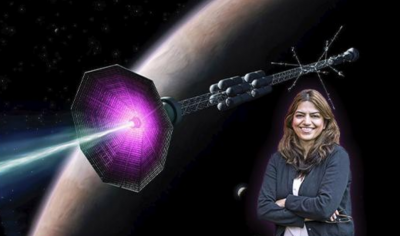NERSC Aids PPPL in Plasma Rocket Breakthrough
March 30, 2021
Contact: cscomms@lbl.gov
A revolutionary new rocket engine design has come out of Princeton University, with an assist from the National Energy Research Scientific Computing Center (NERSC) at Lawrence Berkeley National Laboratory.
In a paper published online in the Journal of Plasma Physics, Fatima Ebrahimi, a research physicist at Princeton Plasma Physics Laboratory (PPPL), outlined how the natural flow of plasma waves generated in stars could be harnessed to greatly improve the performance of plasma-based rocket engines, perhaps one day enabling long-range space travel to Mars and beyond.

PPPL physicist Fatima Ebrahimi in front of an artist's conception of a fusion rocket. Credit: Elle Starkman (PPPL Office of Communications) and ITER
Central to Ebrahimi’s theory is the concept of magnetic reconnection, a phenomenon seen in stars and recreated with doughnut-shaped fusion devices known as tokamaks. In reconnection, lines of magnetic fields connect and separate at various points, generating plasma bubbles with high levels of energy in the process. By recreating this magnetic phenomena with plasma thrusters – which typically rely on deuterium or helium plasma for fuel – far more propulsion could be created than is possible with current electrical plasma ion engine designs. The new design could also allow far more efficient engines than current chemical-based engines and enable deep space travel.
“You have magnetic bubbles (plasmoids) that are being formed,” explained Ebrahimi. “As these bubbles are being ejected from the back of the rocket, you get thrust.”
While the theory was promising, verifying it was not an easy process. A set of complex, high-resolution simulations of plasma physics were needed to confirm the efficiency of the magnetic reconnection design. So Ebrahimi turned to the Cori supercomputer at NERSC and was able to show that the new plasma thruster concept can generate exhaust with velocities of hundreds of kilometers per second, 10 times faster than those of other thrusters.
“Reconnection is a multi-scale problem,” she explained. “You really need to resolve all the scales, therefore the computations become expensive, and that is where the supercomputers come into play."
Over the course of several weeks, Ebrahimi was able to run multiple simulations that could reproduce the higher forces generated by the engine. Eventually, these high-resolution scans were able to prove that the engine would, in fact, generate higher levels of propulsion. The faster velocity at the beginning of a spacecraft's journey could bring the outer planets within reach of astronauts.
Throughout it all, the reliability of NERSC’s supercomputing resources was something PPPL could count on as they worked to validate the theory, Ebrahimi noted.
“You know that NERSC is there and you rely on that,” she said. “NERSC is there when you want high resolution, including more resolution in every direction."
Going forward, she and her colleagues plan to take advantage of every bit of computing power afforded by the next-generation of systems that are set to deploy. Ebrahimi already has plans for how to use the extra muscle afforded by Perlmutter - NERSC’s next supercomputer, a heterogeneous CPU/GPU machine being installed this year - and other new architectures.
“We will probably take full advantage of whatever comes in supercomputing capabilities,” said the Princeton researcher. “There are lots of efforts to modernize the codes that I used with different architectures. We will definitely take advantage of that.”
NERSC is a U.S. Department of Energy Office of Science user facility.
This article includes information from a PPPL news release.
About NERSC and Berkeley Lab
The National Energy Research Scientific Computing Center (NERSC) is a U.S. Department of Energy Office of Science User Facility that serves as the primary high performance computing center for scientific research sponsored by the Office of Science. Located at Lawrence Berkeley National Laboratory, NERSC serves almost 10,000 scientists at national laboratories and universities researching a wide range of problems in climate, fusion energy, materials science, physics, chemistry, computational biology, and other disciplines. Berkeley Lab is a DOE national laboratory located in Berkeley, California. It conducts unclassified scientific research and is managed by the University of California for the U.S. Department of Energy. »Learn more about computing sciences at Berkeley Lab.







